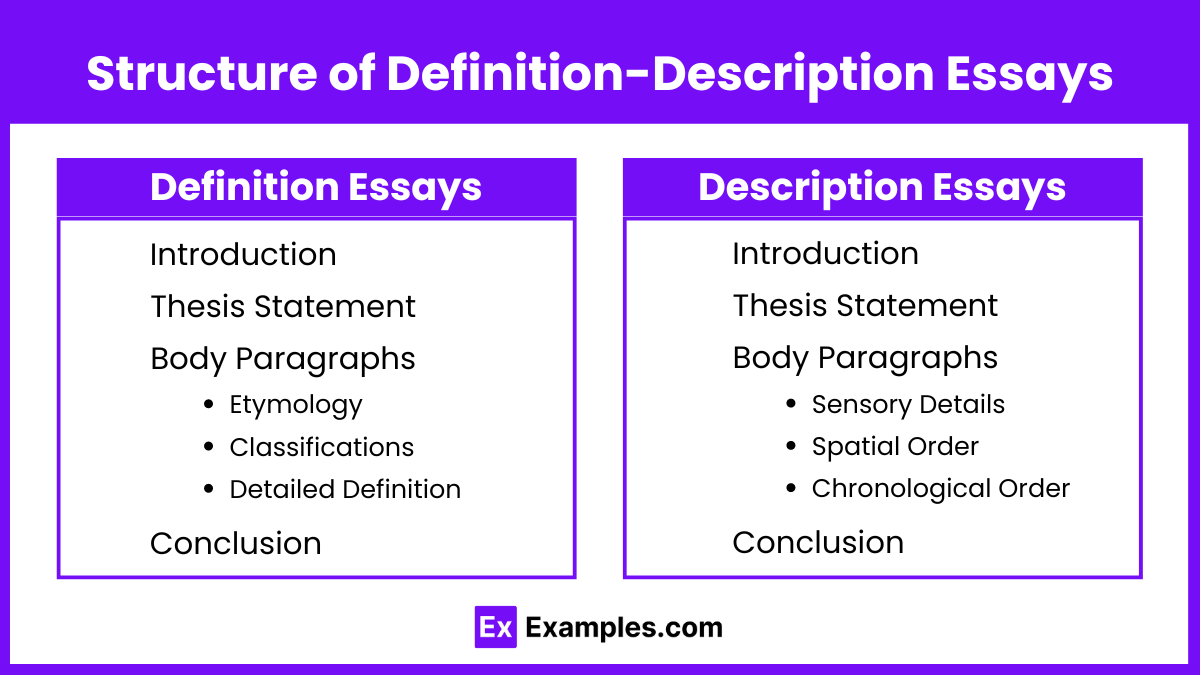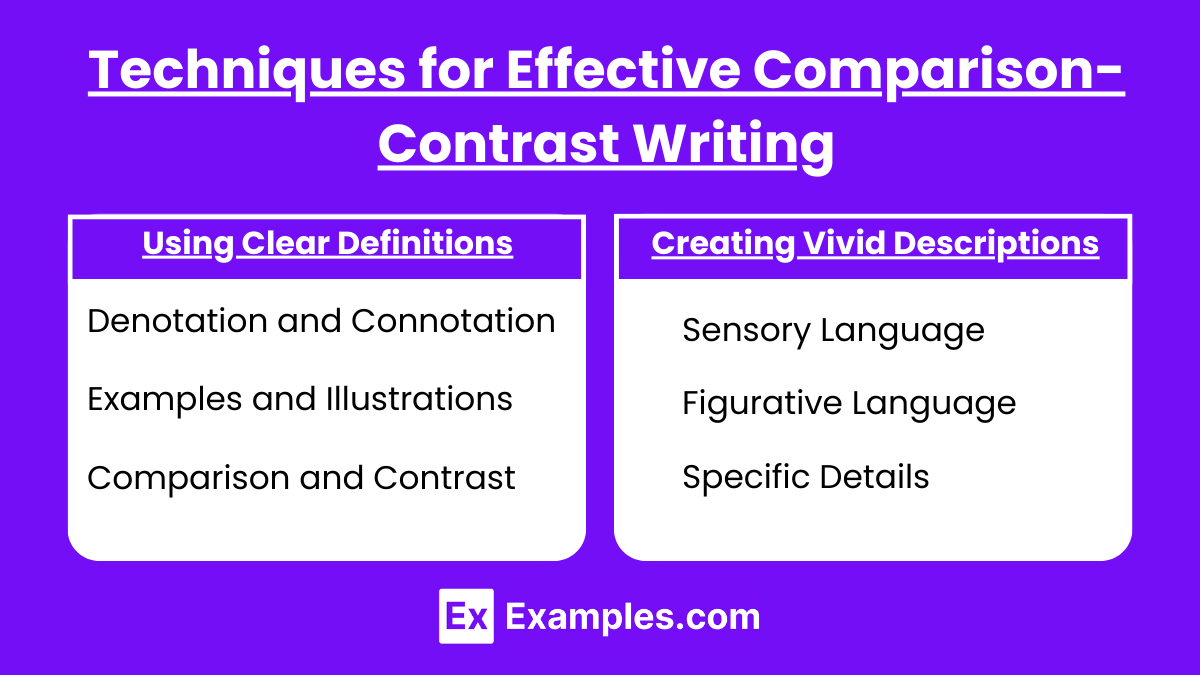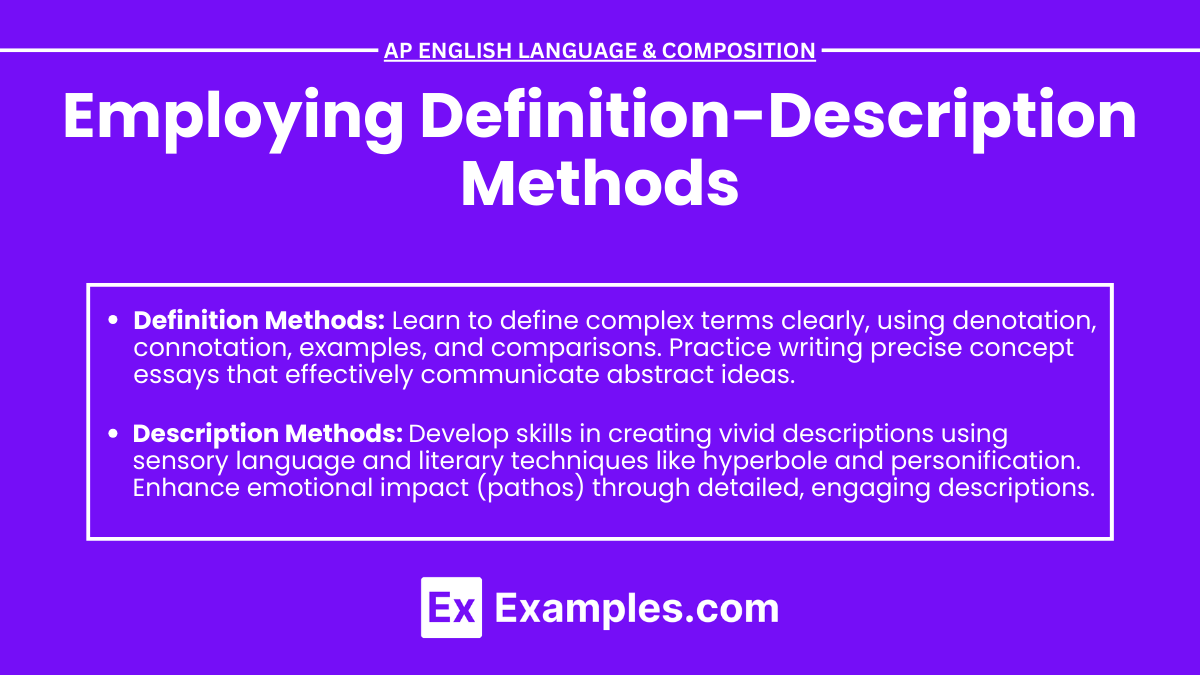In the AP English Language and Composition exam, mastering the use of definition-description methods is essential for crafting clear and engaging essays. These techniques enhance your ability to explain complex concepts and create vivid imagery, crucial for developing a strong rhetorical analysis thesis statement. By employing these methods, you can effectively utilize rhetorical strategies to enhance your arguments and connect with your audience. Whether you are writing a descriptive essay or analyzing a text, understanding how to define and describe will improve the clarity and impact of your writing, making your essays more persuasive and compelling.
Learning Objectives
By studying the topic of employing definition-description methods, students will achieve several key learning objectives. They will learn to use literary techniques such as hyperbole and personification to create vivid and engaging descriptions. Students will understand how to write effective concept essays by clearly defining abstract ideas and providing detailed explanations. They will enhance their ability to evoke pathos by using descriptive language that appeals to the reader’s emotions. Mastery of these techniques will enable students to produce clear, precise, and impactful writing that effectively communicates complex ideas and resonates with their audience.
Understanding Definition-Description Methods
Definition involves explaining the meaning of a term or concept, providing a clear and precise explanation to ensure the reader understands it.
Description involves using sensory details and vivid language to create a detailed picture of a subject, making it more tangible and engaging for the reader.
Purpose
- Clarify Concepts: Ensure readers understand key terms and ideas.
- Enhance Understanding: Provide detailed descriptions to make concepts more relatable and vivid.
- Engage Readers: Use descriptive language to captivate and hold the reader’s attention.
Structure of Definition-Description Essays

Definition Essays
- Introduction: Introduce the term or concept and provide a general definition.
- Thesis Statement: Present the specific aspect of the term or concept you will explore.
- Body Paragraphs:
- Etymology: Discuss the origin and history of the term.
- Classifications: Explain the different categories or types.
- Detailed Definition: Provide an in-depth explanation, including denotation and connotation.
- Conclusion: Summarize the key points and restate the significance of understanding the term.
Description Essays
- Introduction: Introduce the subject to be described.
- Thesis Statement: Present the main focus of the description.
- Body Paragraphs:
- Sensory Details: Use details related to sight, sound, smell, taste, and touch.
- Spatial Order: Organize descriptions based on location or arrangement.
- Chronological Order: Describe events or processes in the order they occur.
- Conclusion: Summarize the main points and emphasize the importance or impact of the description.
Techniques for Effective Definition-Description Writing

Using Clear Definitions
- Denotation and Connotation: Explain both the literal meaning and the associated meanings of the term.
- Examples and Illustrations: Provide concrete examples to clarify abstract concepts.
- Comparison and Contrast: Compare the term with similar or opposing terms to highlight its unique features.
Creating Vivid Descriptions
- Sensory Language: Use descriptive language that appeals to the senses.
- Figurative Language: Incorporate metaphors, similes, and personification to enhance imagery.
- Specific Details: Focus on precise details to create a clear and vivid picture.
Examples
Example of a Definition Essay
Term: “Courage”
Introduction: “Courage is often celebrated in literature and history, but what does it truly mean?”
Thesis Statement: “Courage involves not only facing physical dangers but also standing up for one’s beliefs and making difficult choices.”
Body Paragraphs:
- Etymology: “The word ‘courage’ originates from the Latin word ‘cor,’ meaning heart.”
- Classifications: “Physical courage, moral courage, and emotional courage are distinct types.”
- Detailed Definition: “Courage is the ability to confront fear, pain, danger, or adversity with resolve and bravery.”
Conclusion: “Understanding courage helps us appreciate the sacrifices and challenges individuals face in their pursuit of justice and truth.”
Example of a Description Essay
Subject: “A Summer Day at the Beach”
Introduction: “A day at the beach in summer is a sensory feast that evokes relaxation and joy.”
Thesis Statement: “The beach offers a perfect blend of natural beauty and recreational activities, making it an ideal summer retreat.”
Body Paragraphs:
- Sight: “Golden sands stretch to meet the azure waves, dotted with colorful umbrellas and sunbathers.”
- Sound: “The rhythmic crashing of waves and the cheerful cries of seagulls create a soothing symphony.”
- Smell: “The salty tang of the sea air mingles with the scent of sunscreen and fresh seafood.”
- Touch: “The warm sand feels soft underfoot, while the cool water provides a refreshing contrast.”
- Taste: “Enjoying a cold, sweet ice cream cone under the blazing sun is a delightful treat.”
Conclusion: “A summer day at the beach offers an immersive experience that rejuvenates the mind and body.”


